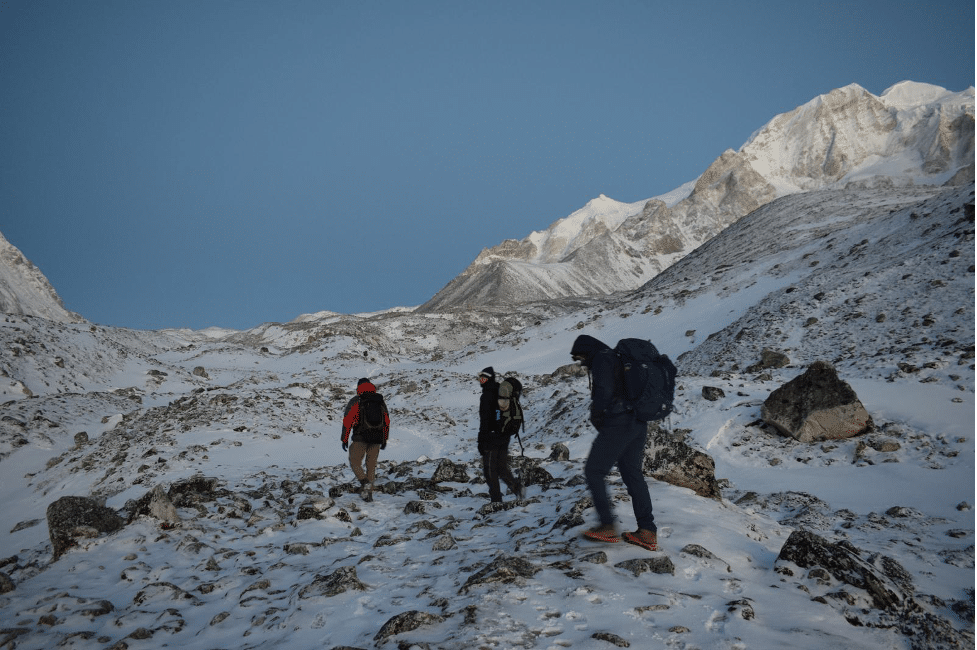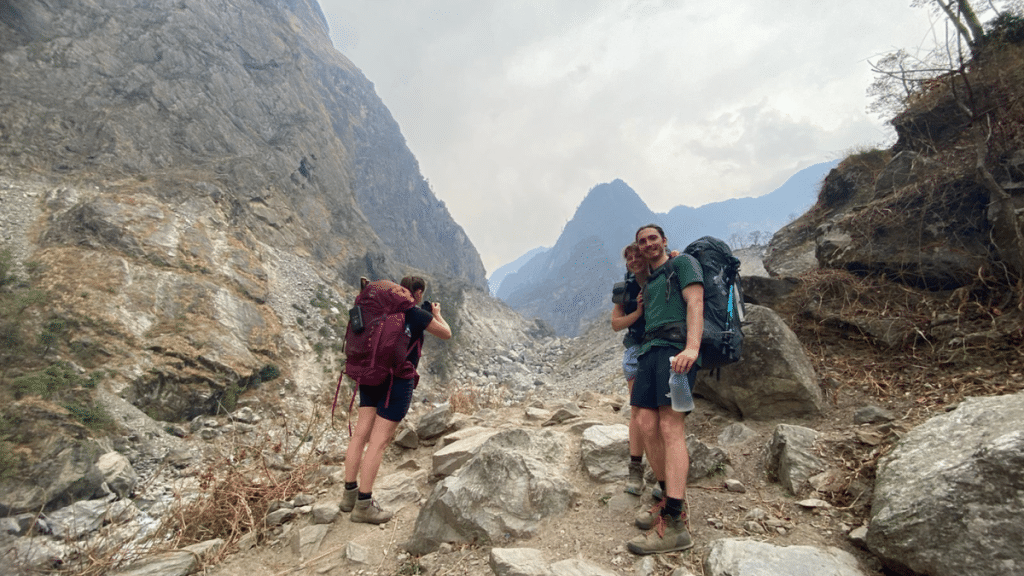Trekking in Nepal is an adventure many people dream about. It lets you explore some of the most beautiful places on Earth, from the snow-capped mountains to lush green valleys. Whether you’re trekking to Everest Base Camp, the Annapurna Circuit, Manaslu, or other well-known trails, having the right gear is very important for a safe and fun journey. The weather and trail conditions in Nepal can change quickly, and being prepared can make all the difference in your trekking experience. This guide provides a detailed packing list for trekking in Nepal, customized for all seasons to help you be well-prepared and ready for anything you might face.
Understanding the Trekking Seasons in Nepal

To get ready for trekking in Nepal, it’s important to know how the season affects what you need to pack. The conditions vary a lot depending on the time of year, and this can impact both your comfort and safety on the trail.
Trekking in Spring (March-May)
Spring is one of the best times to trek in Nepal. The temperatures are mild, and flowers like rhododendrons are blooming all over the hillsides. The weather is usually stable, which makes it great for enjoying nature and taking in the breathtaking views. In spring, it’s important to pack light layers, moisture-wicking clothes to keep you dry, and lightweight trekking pants. You will also need sun protection, as the sun can be quite strong during the day. Nights can still be a bit chilly, so make sure to bring a warm fleece or jacket.
Trekking in Autumn (September-November)
Autumn is the most popular season for trekking in Nepal because of the clear skies and great weather. The temperatures are perfect for hiking—not too hot during the day and not too cold at night. You’ll need layers to stay warm in the morning and evening, and a good jacket for the cooler nights. This is the season when you get the best mountain views, so make sure to bring a camera. Autumn is also when the trails are busiest, so it’s a good idea to plan ahead for accommodation and gear.
Winter and Monsoon Considerations
Winter (December-February) is very cold, especially in high places. However, the trails are less crowded, and if you don’t mind the cold, it can be a beautiful time to trek. Bring a warm down jacket, thermal base layers, gloves, and other cold weather gear to stay comfortable. During the monsoon (June-August), the trails can be wet and muddy, and visibility may be low due to rain and clouds. Make sure you have rain gear like a waterproof jacket, a backpack cover, and clothes that dry quickly. Leech protection is also recommended if you are trekking in lower altitudes during the monsoon.
Essential Packing List for Trekking in Nepal
Clothing and Footwear
- Trekking Boots: Make sure they are sturdy and already broken in. Blisters can be a major issue if your boots aren’t comfortable.
- Moisture-Wicking Base Layers: These keep you dry and comfortable on long hikes. Staying dry is important to avoid getting chilled.
- Thermal Wear: Important for high altitudes where it gets really cold, especially at night. Thermals can be worn under your regular clothes to keep you warm.
- Trekking Pants: Lightweight pants that dry quickly are the best. Convertible pants that can turn into shorts are also a good idea.
- Jacket: A down jacket is good for cold nights and high places. A waterproof shell is also helpful in case of unexpected rain.
Trekking Gear
- Backpack (40-50L): Big enough to carry what you need each day without being too heavy. Look for one with a comfortable harness and good back support.
- Trekking Poles: These help you stay steady, especially on steep or rough paths. They reduce the strain on your knees and help with balance.
- Sleeping Bag: Bring a warm sleeping bag for cold nights, especially if you’re staying in teahouses that may not have enough blankets. A sleeping bag liner can add extra warmth.
- Headlamp: A headlamp is important for early starts or if you need to walk at night. Make sure to bring extra batteries.
Accessories
- Sunglasses: Protect your eyes from the sun, especially at high altitudes where UV exposure is stronger.
- Gloves and Hat: Warm gloves and a hat are needed for cold mornings and nights. A sun hat is also helpful during the day to protect your face and neck.
- Gaiters: Keep dirt, rocks, and water out of your boots, especially during the monsoon or when trekking in snowy areas.
Personal Items and Toiletries
- Sunscreen and Lip Balm: Use a high SPF to protect your skin from strong sun. The sun is stronger at high altitudes, and sunburn can happen quickly.
- Wet Wipes and Hand Sanitizer: Useful when there isn’t much water for washing. Staying clean can help prevent illnesses.
- First Aid Kit: Include things like blister pads, painkillers, bandages, antiseptic cream, and any personal medications. A well-stocked first aid kit is essential for treating minor injuries.
Miscellaneous Items
- Snacks: Energy bars, trail mix, and dried fruit are great for keeping your energy up. Snacks can be hard to find or expensive in remote areas.
- Water Bottles and Purification Tablets: Staying hydrated is very important, especially at high altitudes where dehydration happens faster. Purification tablets or a water filter can help you avoid buying bottled water, which reduces plastic waste.
- Multi-tool: Handy for small repairs and unexpected needs. A Swiss Army knife or similar tool can be useful in many situations.
Packing for Specific Treks in Nepal
Manaslu Circuit Packing Tips
The Manaslu Trekking Area is less crowded and requires more self-reliance. Pack warm clothes for the high passes like Larkya La, and bring a sturdy tent and sleeping bag if you plan to camp. Since the facilities are more basic, bring extra snacks and a good water purification system. For more information on the best trekking seasons in Nepal, visit this guide. Make sure to also bring a portable charger, as electricity might not be available in all teahouses.
Everest Base Camp Packing Tips
For the Everest Base Camp trek, pack for cold weather, as the temperatures can drop below freezing, especially at night. You need layered clothes, a good sleeping bag rated for cold temperatures, and warm gloves to handle the high-altitude cold. Don’t forget to bring sunglasses and sunscreen, as the sun’s reflection off the snow can be very strong.
Annapurna Circuit Packing Tips
The Annapurna Circuit has a mix of climates, ranging from warm lowlands to cold mountain passes. Pack lighter clothes for the lower parts and warm layers for the higher sections. Since tea houses are easy to find, you can pack fewer supplies and rely on these stops for food and rest. However, bring cash, as ATMs are not available in the remote areas.
Tips for Packing Light and Smart
Choosing Multi-Purpose Gear
Pick gear that can be used in more than one way, like pants that convert to shorts or a jacket with removable layers. This will help keep your pack lighter and more manageable. Multi-purpose gear saves space and weight, making your trek more enjoyable.
Packing for High Altitude Treks
Layering is key for high-altitude treks because the temperature can change a lot. Bring base layers, mid-layers, and a warm jacket to stay comfortable. A good layering system allows you to adjust your clothing based on the weather and your activity level, which helps you stay comfortable and avoid overheating or getting too cold.
Packing Do’s and Don’ts for Trekking in Nepal
Do’s: What You Should Definitely Pack
- Do pack layers: Layers help you stay comfortable with changing temperatures. The weather can be unpredictable, so it’s best to be prepared.
- Do bring high-energy snacks: These will help you stay energized during long days of hiking. Snacks can also be a nice morale boost when you’re feeling tired.
Don’ts: Items You Can Leave Behind
- Don’t overpack clothing: Many tea houses have laundry services, so you can wash clothes along the way. This will help keep your backpack light.
- Don’t carry too many gadgets: Keep electronics to just what you need, like a camera and phone. Extra gadgets add weight and can be a hassle to keep charged.
Conclusion
Packing the right way is very important for having a safe and successful trek in Nepal. With the right gear, you’ll be ready for the different climates and challenges on the trail. Make sure to double-check this list before your adventure begins. It’s better to be well-prepared than to find yourself without something essential in a remote area. Whether you are a seasoned trekker or a first-timer, proper packing will make your adventure much more enjoyable and stress-free.
FAQ Section
Do I need a sleeping bag? Yes, especially for higher altitudes where it gets very cold at night. Even in teahouses, the blankets provided may not be enough to keep you warm.
Can I rent gear in Nepal? Yes, Kathmandu has many rental options for good quality trekking gear. Renting is a great option if you don’t want to buy expensive gear or if you’re only trekking once.
Do I need a guide for trekking in Nepal? While some trails can be done independently, hiring a guide is highly recommended, especially for remote areas like Manaslu or during the off-season. A guide can help with navigation, language barriers, and emergencies.
How much cash should I bring? It’s important to bring enough cash for the entire trek, as ATMs are not available in remote areas. This includes money for food, accommodation, permits, and any extra expenses.
